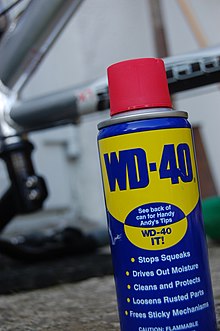WD-40
 | |
| Company type | Public (Nasdaq: WDFC) |
|---|---|
| Industry | lubrication |
| Genre | lubrication |
| Founded | 1953 |
| Headquarters | San Diego, California |
| Products | lubrication |
| Website | http://www.wd40.com |


WD-40 is the trademark name of a water-displacing spray widely available in a variety of retail outlets. Developed in 1953 by Norm Larsen, then working for the San Diego Rocket Company, it was originally designed to repel water and prevent corrosion,[1] and later was found to have numerous household uses.
WD-40 stands for Water Displacement, 40th formula. Larsen was attempting to concoct a formula to prevent corrosion, by displacing the standing water that promotes it. In the process, he arrived at a successful formula on his 40th attempt.[1] WD-40 is primarily composed of various hydrocarbons.
WD-40 was first used by Convair to protect the outer skin of the Atlas missile from rust and corrosion.[1] The product first became commercially available on store shelves in San Diego in 1958.[1]
Function
The long term active ingredient is a non-volatile, viscous oil which remains on the surface, providing lubrication and protection from moisture. This is diluted with a volatile hydrocarbon to give a low viscosity fluid which can be sprayed and thus get into crevices. The volatile hydrocarbon then evaporates, leaving the oil behind. A propellant (originally a low-molecular weight hydrocarbon, now carbon dioxide) provides gas pressure in the can to force the liquid through the spray nozzle, then itself diffuses away.
These properties make the product useful in both home and commercial fields; lubricating and loosening joints, removing dirt and residue, and preventing rust are common usages. The product may also be useful in removing moisture, particularly in electrical components.
Formulation
WD-40's main ingredients, according to U.S. Material Safety Data Sheet information, are:
- 50%: Stoddard solvent (i.e., mineral spirits -- primarily hexane, somewhat similar to kerosene)
- 25%: Liquefied petroleum gas (presumably as a propellant; carbon dioxide is now used instead to reduce WD-40's considerable flammability)
- 15+%: Mineral oil (light lubricating oil)
- 10-%: Inert ingredients
The German version of the mandatory EU safety sheet lists the following safety relevant ingredients:
- 60-80%: Heavy Naphtha (petroleum product), hydrogen treated
- 1-5%: Carbon dioxide
It further lists flammability and effects to the human skin when repeatedly exposed to WD-40 as risks when using WD-40. Nitrile rubber gloves and safety glasses should be used. Water is unsuitable for extinguishing burning WD-40.
There is a popular urban legend that the key ingredient in WD-40 is fish oil.[2]
WD-40 company

In 1969, the San Diego Rocket Company renamed itself WD-40 after what was then its only product, but WD-40 was still sold as "Rocket WD-40" for many years, with the history of its use in preserving Atlas rockets printed on each can. The company went public in 1973. Its NASDAQ stock symbol is (Nasdaq: WDFC). In recent years the WD-40 company has acquired several household-products companies, adding such brand names as 3-In-One Oil, Lava, Spot Shot, X/14, Carpet Fresh, and 2000 Flushes to its roster. The company still has its corporate offices in San Diego, California.[3] It now markets its products in more than 160 countries around the world. In 2003, it recorded sales of $238.1 million.
See also
- WD-40 - a diesel tractor built by IHC/McCormick-Deering in the 1930s.
- Spy Hard - a movie featuring an agent with codename WD-40.
Similar products
- Selleys RP7
- GT85
- Zorrik 88
- CRC 5-56
- Caramba (in Europe/Germany), marketed since 1874, trademarked in 1903.
- MOS6 by Molycote
- Boeing Boeshield T-9
References
- ^ a b c d "Our History". WD-40.
- ^ Mikkelson, Barbara & David P. "Uses for WD-40" at Snopes.com: Urban Legends Reference Pages.
- ^ Killion, Andy (2007-04-09). "Revenue, Net Income Both Rise at WD-40". San Diego Business Journal. Retrieved 2007-04-13.
{{cite news}}: Check date values in:|date=(help); External link in|publisher=
